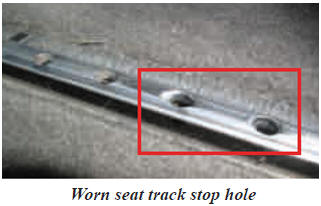|
|||||||||||
|
|
|
|||
|
By Mike Mitchell |
||||
 |
September 7, 2010 - The FAA has released a Safety Alert for Operators (SAFO) regarding missing or improper seat stops in Cessna aircraft models. The SAFO is to remind inspectors, operators, owners and maintenance technicians that a certain type design seat stops are required to be installed on all seat rails to meet airworthy requirements. Missing or improper seat stops have been found on several Cessna models including 150, 152, 172 and 206. These seat stops are also found on Cessna models 303, 336 and 337; and all legacy (pre-1987) single-engine Cessna models 170, 175, 177, 180, 182, 185, 188, 190, 195, 205, 207 and 210. Cessna has identified seat stops as an important piece of equipment required for safety by inserting a warning note into their service manuals to ensure that seat stops are installed in the proper positions on the rails for each seat. |
|||
|
|
||||
|
Seat stop is
designed to assist in providing an additional margin of safety by
limiting the aft travel of the seat in the event the primary latch pin
is not properly engaged in the seat rail/track. In certain instances,
seat slippage could result in some pilots not being able to reach all
the controls and/or subsequently losing control of the airplane.
The Cessna service
manual recommends inspection of seat stops at the 100 hour, annual
inspection, although not all of the Cessna service manuals provide
instructions that specifically address inspection of the stops for
condition, proper location or that the stops are approved parts. There are numerous cases were pilots have found themselves in trouble due to their seat failing to remain locked to the seat rail. Below are two cases were the pilots seat became unlatched at a crucial point in flight. |
||||
On August 14,
1989, a Cessna A185E, N95KW, was on a normal approach for runway 36 |
||||||
|
|
||||||
| Other News Stories |
||||||
| ?AvStop
Online Magazine
Contact
Us
Return To News
|
||||||
|



